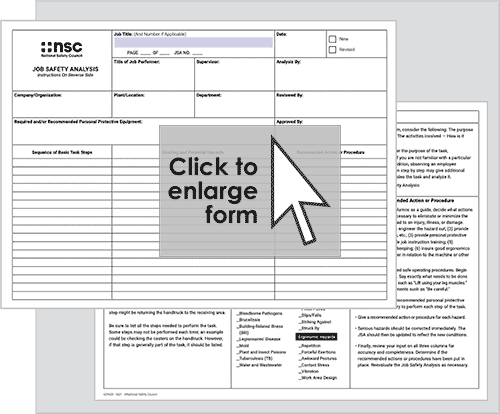Job Safety Analysis
A look at the process – and its benefits

Page 2 of 3
Steps of a JSA
According to NSC and MDOL, conducting a JSA involves essentially three main steps:
- Observe step by step how a worker does the task.
- Look for possible hazards in each step of the task.
- Review the list of hazards with employees who perform the task. These workers can help formulate suggestions for eliminating or reducing the hazards in each step.
Those three steps can serve as the basis for a chart with the columns in order from left to right:
- The tasks or the steps of a task
- The potential hazards
- Recommendations

NSC recommends numbering each step and listing the steps in the order they’re performed. Use action words such as “load,” “steer” or “unload.”
Try to briefly describe the steps (e.g., “Lift the load and back out”) and avoid being too detailed (e.g., “Lift the load with the fork slightly raised and back out slowly”). “By being brief, we can keep it to the point and (have) a one-page document that’s easily referenced – and therefore used,” Dankert said.
MDOL suggests using videotape or photography when putting together the list. Finally, employers should review the steps with workers to make sure the list is complete.
Questions about hazards
When attempting to identify hazards, MDOL says the questions to think about are:
 What can go wrong?
What can go wrong?
 What are the consequences?
What are the consequences?
 How could it happen?
How could it happen?
 What are other contributing factors?
What are other contributing factors?
 How likely is it that the hazard will occur?
How likely is it that the hazard will occur?
According to NSC, other questions to ask when seeking to identify hazards are:
- Is there danger of striking or being struck by an object?
- Is there a danger of being caught in, by or between objects?
- Is there a danger of slipping, tripping or falling?
- Can pushing, pulling, lifting, bending or twisting cause strain?
- Is there a danger of harm to eyes, hands, feet or other parts of a worker?
Post a comment to this article
Safety+Health welcomes comments that promote respectful dialogue. Please stay on topic. Comments that contain personal attacks, profanity or abusive language – or those aggressively promoting products or services – will be removed. We reserve the right to determine which comments violate our comment policy. (Anonymous comments are welcome; merely skip the “name” field in the comment box. An email address is required but will not be included with your comment.)

